Everything You Can Do With a Wok
A wok is one of the most versatile cooking vessels in the kitchen, and this list proves it.
We here at Serious Eats have sung the praises of the wok many times over the years, and that's because the wok is one of the most versatile cooking vessels in the kitchen.
Of the pans I own, the only one that comes close to being used as often as my wok is my cast iron skillet, which is superior only in that it can be used for baking and for searing large pieces of meat. For most other tasks—for stir-frying, sure, but also for sautéing vegetables quickly, or browning cubed meat—I'll reach for my wok.
Yet even those who've owned a wok and used it frequently for years rarely use it to its full potential. To that end, we thought it would be helpful to lay out its manifold uses in one place, with illustrative examples of each. One of these uses—dry-frying—is specific to Sichuan cuisine, but the others—stir-frying, "braising," steaming, smoking, and deep-frying—are applicable to every cuisine in the world. You may find that a wok serves you better than some of the other cooking vessels you'd typically use for everyday tasks.
Beyond that, the convenience of using a wok for things like steaming and deep-frying could convince you to make some recipes more regularly. For example, after you've fried a few things in your wok and discovered how much better it contains spatter, you might be tempted to consider Southern fried chicken an easy choice for a weeknight dinner (because it is!).
What Kind of Wok Are We Talking About?
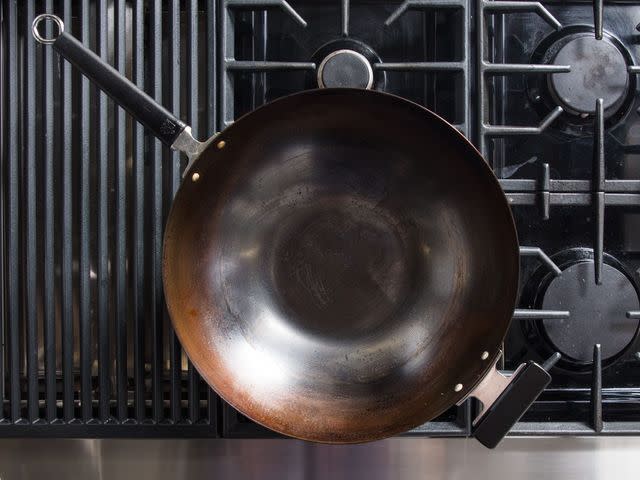
Serious Eats / Vicky Wasik
Before we get into what you can do with a wok, we should note that we're talking about a good wok. That is, a solidly constructed carbon steel wok of a sufficient thickness with a flat bottom for use on a typical stovetop burner.
Our guide to buying and caring for a wok recommends the Joyce Chen flat-bottomed carbon steel wok. If you take care of it properly and season it well, it should last you a very, very long time, and it's more than capable of handling any of the techniques outlined below.
For those of you with an electric stovetop, don't despair. A flat-bottomed wok will definitely work on an electric range, and is still superior for stir-frying and the like than any other pan in your kitchen.
Stir-Frying
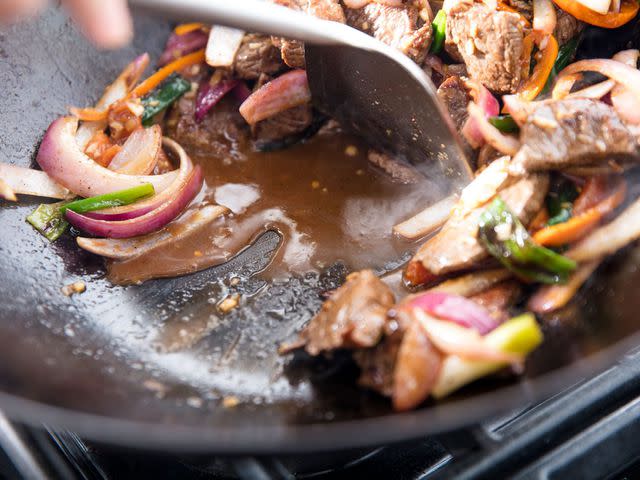
Serious Eats / Vicky Wasik
When most people think of what a wok can do, their first thought is stir-frying. That's understandable, given that the wok excels at it. Its sloped sides make it ideal for tossing and flipping food quickly and efficiently, and because it's made from carbon steel (which retains heat very well), the food that you toss and flip repeatedly will be exposed to an enormous amount of heat when it comes in contact with the pan, imbuing it with charred flavor without overcooking it.
On top of that, the vaporized oil generated by that high heat will combust as you toss it over an open flame, creating dramatic pyrotechnics and, more importantly, wok hei, the singular flavor that defines stir-fry. The result: tender bits of great-tasting meat, and tender-crisp, somewhat smoky vegetables.
Because stir-frying is a quick, high-heat cooking method, there are several things to keep in mind when preparing any stir-fry. The first is that the pieces of food you're going to cook should be cut to a uniform size, and you'll typically want to cut whatever you're stir-frying—be it cabbage or carrots or onions—into small pieces. (There are some exceptions, such as long beans and string beans.)
Second, you'll want to take out some insurance against overcooking your proteins, whether that comes in the form of dry-brining shrimp with baking soda or velveting slivered proteins.
Finally, to ensure that all the elements of a stir-fried dish cook properly over a home stovetop burner's lower heat (compared with a wok burner), you may want to try stir-frying in small batches, whether you're making kung pao chicken or the fantastic Chinese-Peruvian dish lomo saltado (pictured above).
You can read our guide to how to stir-fry in a wok for more instructions, and get the recipe for lomo saltado here.
Steaming
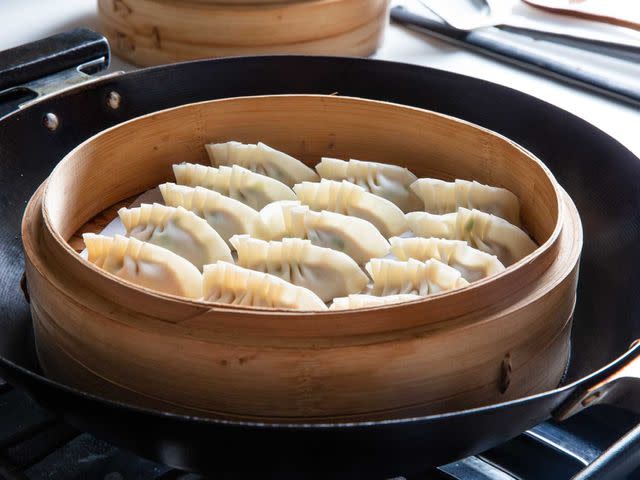
Serious Eats / Vicky Wasik
I reach for my wok almost as frequently to steam as I do to stir-fry, and, while I now own a bamboo steamer specifically for use in my wok, there's no need to purchase a unitasker for the purpose.
You can use a metal steamer insert, or you can use the steamer insert that came with another appliance, like an Instant Pot; you can even invert one of those flimsy aluminum takeout containers and use it to hold the food above the water, if you like, although you'll want to perforate it a number of times with a skewer or the tip of a paring knife. So long as you can (safely) elevate a plate or whatever you want steamed above a pool of simmering water in the wok, you can steam.
But I'd like to make a case for the bamboo steamer, since it has a couple of advantages. The first is that the steamer trays are stackable, multiplying the number of things you can steam at one time. The second is that it comes with its own lid, which is (marginally) easier to clean than the large, unwieldy lid that comes with our recommended wok.
Regardless of what you use for your steamer setup, the applications are too numerous to mention. For my part, I steam many pounds of vegetables a week, mostly for my kid; I use the steamer for dumplings, as pictured above; I use it for small whole steamed fish or fish fillets; I even use it for custards, like chawan mushi.
Learn more about how to steam in a wok, or get the recipe for simple pork and scallion dumplings here.
Braising
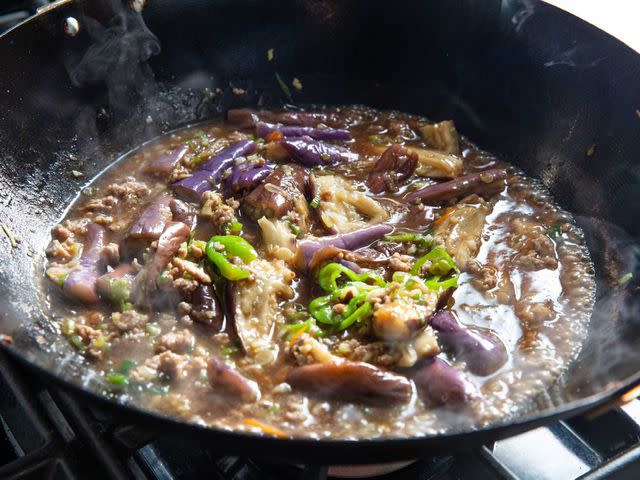
Serious Eats / Vicky Wasik
When you're talking about wok cooking techniques, "braising" is something of a misnomer. Rather than the low-heat, moist cooking method that's meant to convert collagen in tough meats to gelatin—what we typically refer to as "braising" in Western cuisines—"wok braising" essentially creates a simmered dish. While a stir-fried dish might have just enough sauce to coat each morsel of food contained within it, a wok-braised dish will have a decidedly saucy consistency. Think mapo tofu, or the braised eggplant pictured above.
If the idea of using a wok for these kinds of recipes reminds you of the old "when all you have is a hammer..." adage, you should know that the wok provides a benefit that a straight-sided pot, like a Dutch oven (or even a less-sloped vessel, like a saucier), does not—namely, that you can stir the contents of the wok quite easily without resorting to a utensil.
A wok allows you to jiggle and swirl the contents, while the high, sloping sides contain the sloshing. Just try to pull that off with a Dutch oven! The other benefit of a wok is that it's very easy to pour a saucy dish out of the wok directly into a serving vessel.
Learn more about how to braise in a wok, or get the recipe for braised eggplant with pork in Sichuan sauce here.
Deep-Frying
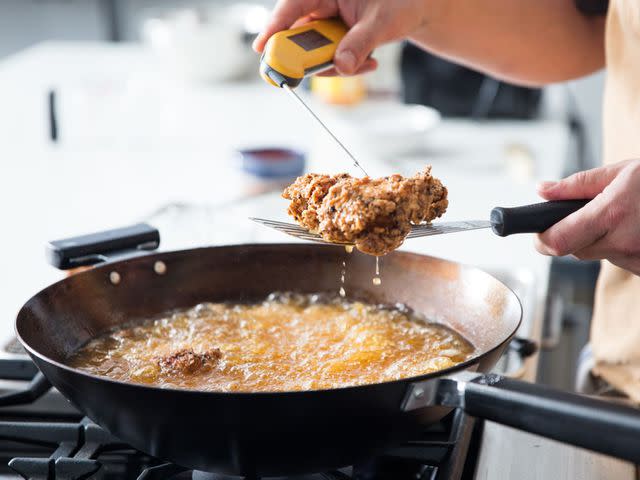
Serious Eats / Vicky Wasik
I actually think deep-frying is the kitchen task the wok excels at above all others, but I've placed it this far down on the list because, as great as deep-frying in a wok is, I still deep-fry at home a lot less frequently than I stir-fry, steam, or braise. The main reason for that has nothing to do with the wok and everything to do with using and disposing of lots of oil, which I'm sure most home cooks share with me.
If one were to compare deep-frying in a wok with deep-frying in a cast iron pot or a Dutch oven, one would find the wok to be a far better vessel. It's true that the wok's sloped sides mean you'll need more oil to achieve a comparable depth, but that's the only way in which a wok is inferior.
Otherwise, those sloped sides make it easier to hold tools, like chopsticks and strainers, at a variety of angles to manipulate frying food; they make it more convenient to pour out the oil in order to strain or dispose of it, without spills; and they make it less likely that the oil will boil over while you're frying.
But the best part of using a wok for deep-frying is that there's less mess: The flared-out sides of the wok catch a fair amount of splattering oil that the straighter sides of a Dutch oven or a cast iron pan would miss. The relative ease of deep-frying in a wok makes dishes like fried chicken—whether it's kimchi-brined and Southern-fried, as pictured above, or a gonzo Popeye's clone—much more appealing to cook.
Read our guide to deep-frying in a wok for more information, and get the recipe for Kenji's kimchi-brined fried chicken sandwich here.
Indoor Smoking
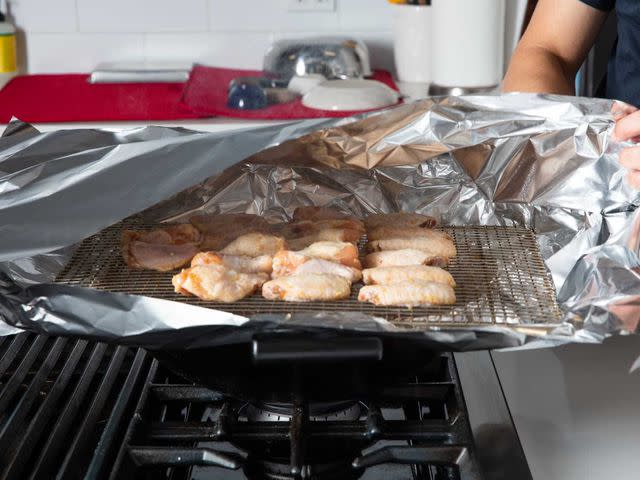
Serious Eats / Vicky Wasik
This is admittedly kind of a niche use for a wok for the home cook, but it shouldn't be! You are limited only by your imagination and the amount of aluminum foil you have on hand (it does require a fair amount of foil). It's easy to do and perfect for any application that requires a light smoke, whether it's the chicken wings pictured here, delicate proteins like fish fillets, or the tofu skin in our vegan cheesesteak recipe.
All you need to do is line your wok with the foil, so that the stuff you're burning to create smoke doesn't mess up the pan's seasoning; top the wok with a wire rack; then top the rack with the food you want to smoke. After you've turned on the flame and the stuff in the bottom of the wok has begun to smoke, seal up the whole thing using another sheet of foil, and let it sit for about 30 minutes, which should be just enough time to impart a light smoky flavor to your food.
Read more about how to smoke foods in a wok in our guide, and get the recipe for tea-smoked chicken wings here.
Dry-Frying
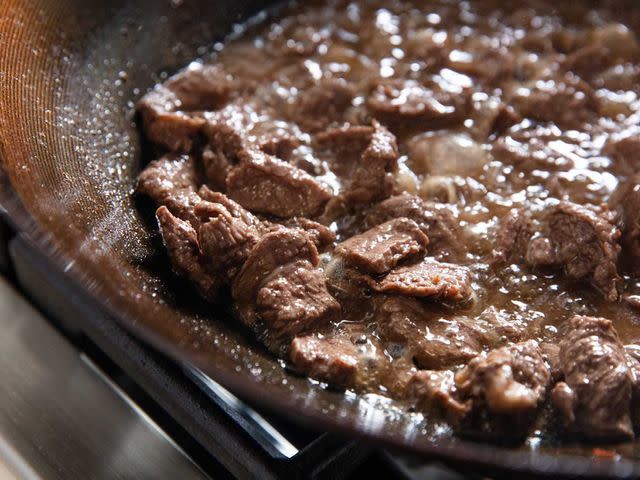
Serious Eats / Vicky Wasik
Specific to Sichuan cuisine, dry-frying is a technique in which a protein (in the example above, beef) or vegetables (such as long beans) are cooked in moderately hot oil in order to drive off almost all the moisture, concentrating the food's flavor and drying out its exterior. After being drained, the food is then stir-fried with very flavorful ingredients—in the case of the beef pictured above, garlic, dried hot chili peppers, and Sichuan peppercorns. The result is highly seasoned morsels of food that are both chewy and pliant.
Find out more about how to dry-fry in a wok, or get the recipe for Sichuan dry-fried beef here.

